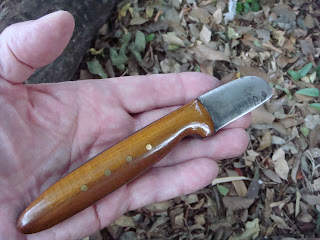If given my druthers I’d rather make my own tools and bushcraft supplies than purchase them at a store. I know many of you feel the same. Of course, there are times when it makes sense to go out and buy the things we need but that’s not as imperative as some would have us believe. And it most certainly doesn’t mean we’ve got to spend a week’s wages on any particular piece of equipment. Indeed, the commercialization of bushcraft seems to run counter to the basic philosophy of making your own, building your own, and venturing out as a Minimalist in gear but a Maximalist in knowledge. Still, that ethos seems lost on a few. Not long ago I stumbled onto a group of “bushcrafters” who were so loaded down with gadgets and tools their packs looked like nylon footlockers strapped across their backs. They looked at my buddy and me as if we were a couple of hobos scouting up a shanty. Perhaps that was the impression we gave with our woolen bedrolls and mosquito nets rolled into small tarps wrapped in twine and strapped across our backs. We carried our food in homemade haversacks slung over our shoulders along with old prospector canteens. A kitchen spoon, tin cup and cooking pot apiece and a little coffee percolator for the two of us along with some basic first aid, extra cordage, SAK knife, a pruning saw and machete made each individual pack begin its journey in the 22-23 pound range. We nodded at the group noting agape mouths and wide-opened eyes and just kept going until we reached a tiny artesian spring hidden in the backcountry.
On that same foray my friend asked me to recommend a stubby field-dressing and skinning knife that wouldn’t tear pelts or clip bladders and guts. I told him I’d think on it and a few weeks later showed him the knives pictured below.
I took some worn out files purchased at a yard sale then annealed them, shaped them, heat treated and tempered the blades. Then wedded the full tang knives to some pieces of Osage orange that were part of a 70 year old fence post, mostly rotting and worm eaten. Brass pins hold the scales in place along with a slathering of epoxy. The top knife measures 6 ½ inches overall with a 1 5/8 inch blade. The blade measures 3/16 inches thick at the spine nearest the handle. The bottom knife measures 6 11/16 inches long with a 2 inch blade that’s 5/32 inch thick at the spine.
Here’s a photo of the 2 inch blade knife in my hand to give you some perspective of its size.
Both knives have convex grinds that give them the strength needed for tasks associated with various camp duties like prying things open or perhaps splitting bone. Ragweed Forge (I have a link to the site in my links section) has started selling a similar knife in both stainless and carbon models called the “Craftline Installer.” It’s advertised as a good knife for striping insulation from wires (to make snares?) and for tasks requiring leverage.
Here’s a smaller version of my “stubby camp knife” collection. The knife measures 5 13/16 inches long with a 1 7/16 inch blade. The blade’s spine width is 6/32 of an inch adjacent to the handle.
It’s surprising how many uses these sturdy knives can have around the camp or workshop or even in the house. The Craftline Installer series sold at Ragweed Forge will probably not be as stout as the knives pictured here but they are inexpensive and perhaps worthy of a some experimentation on your part.





No comments:
Post a Comment